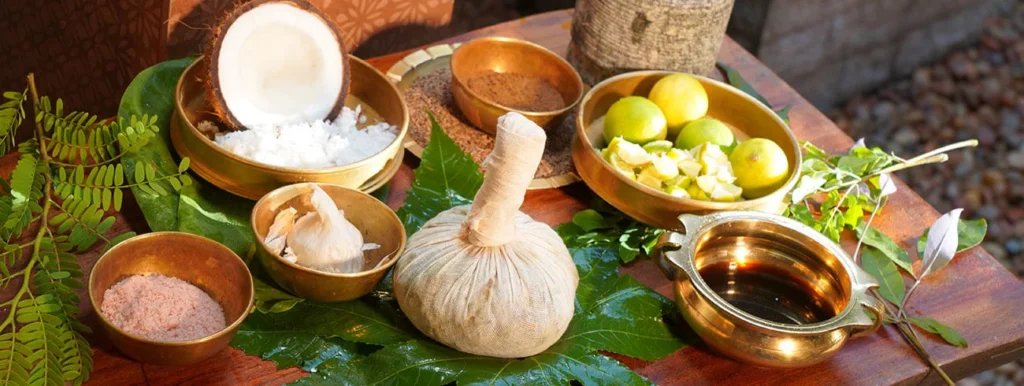Ashtavaidyas: Guardians of Kerala’s Sacred Science of Life

Kerala, often called “God’s Own Country,” is more than a scenic destination—it’s a vital center for the practice of Ayurveda. What makes Ayurveda in Kerala truly distinctive is its unbroken link to Vedic traditions and the legacy of the Ashtavaidyans, the legendary families of Ayurvedic physicians.
Geography played a key role in shaping this legacy. Shielded by the Western Ghats and accessible mainly through the Palakkad Gap, Kerala remained culturally insulated for centuries. This isolation allowed a unique Vedic culture to flourish, preserving ancient Ayurvedic knowledge and rare Vedic texts like the Kausheetakan of the Rigveda—long lost in other parts of India.
Renowned scholar Frits Staal notes:
“In Kerala, we find a tradition that is relatively small, but quite different from the rest of India, and entirely self-contained.”
Much of this continuity was upheld by the Namboothiri Brahmins, custodians of Vedic scholarship, who ensured that Ayurveda remained rooted in its spiritual and scriptural foundations.
The Unique Spectrum of Namboothiri Society-The Othillatha Namboothiris: The Custodians of Ayurveda
Unlike other Brahmanical societies across India, Kerala’s Namboothiris developed a unique internal stratification, which played a crucial role in shaping Kerala’s Ayurvedic tradition. Perhaps the most fascinating aspect of this social structure is the presence of a sub-group of Brahmins excluded from full Vedic authority—the “Othillatha Namboothiris”, literally meaning “Namboothiris without Othu,” with Othu being the colloquial Malayalam word for Vedam.
These Othillatha Namboothiris included:
- Chaathira Namboothiris, who specialized in martial activities.
- Adukkala Namboothiris, who oversaw large-scale ritual cooking
- Keezh-santhi Namboothiris, temple priests involved in lower-tier rituals
While they studied the basic Samhitha texts (the core of the Vedas), they did not pursue the deeper philosophical or ritual components such as the Brahmanam, Aaranayakam, or Upanishads. Nor did they engage in high Vedic rites or oral recitation practices. Yet, it was among these Othillatha Namboothiris that Ayurveda found its most devoted custodians—a group that came to be known as the Ashtavaidyans.
Ashtavaidyans: Kerala’s Legendary Healers
The Ashtavaidyans were Kerala’s hereditary Ayurvedic physicians, most of whom emerged from the Othillatha Namboothiri families. They were masters of the eight classical divisions (Ashtaangams) of Ayurveda:
- Kaayachikitsa (General Medicine)
- Baalachikitsa (Pediatrics)
- Grahachikitsa (Psychiatry & Spiritual Healing)
- Oordhwangachikitsa (ENT & Ophthalmology)
- Salyachikitsa (Surgery)
- Damshtrachikitsa (Toxicology)
- Jarachikitsa (Geriatrics)
- Vrishachikitsa (Aphrodisiac Therapy)
These “Poorna Vaidyas” or complete physicians were not just healers, but also scholars and authors. Their contributions include influential works like Chikitsa Manjari, Yogamithram, Abhidhana Manjari, Alathur Manipravalam, and the Kairaly Commentary on Ashtanga Hridayam.
According to N.V.K. Varier’s Ayurveda Charithram, the title “Ashtavaidyans” originally referred not to eight specific families but to 18 Ashtaangavaidyans, each serving one of the 18 Sabhaamadhams (Vedic schools) across Kerala. These learned physicians catered to 32 Graamams (Brahmin settlements), offering their medical expertise in all eight branches of Ayurveda.
Here is the list of the original Ashtavaidyans and their lineage:
| 1. Alathiyoor Nambi | 1.Aalathiyoor Nambi 2. Kaarathol Nambi 3. Choondal Mooss |
| 2. Elayidath Thaikkatt Mooss | 4. Elayidath Thaikkatt Mooss 5. Kuriyedath Mooss (Njarakkal Mooss) 6. Kurumbempilly Mooss 7. Paduthol Mooss |
| 3. Pazhanellippurath Thaikkatt Mooss | 8. Pazhanellippurath Thaikkatt Mooss 9. Peringavu Mooss 10. Parappur Mooss |
| 4. Kuttancherry Mooss | 11. Kuttancherry Mooss 12. Vatuthala Mooss 13. Akalaanath Mooss |
| 5.Vayaskara Mooss | 14. Vayaskara Mooss |
| 6. Chirattamon Mooss | 15. Chirattamon Mooss (Olassa Mooss) |
| 7. Velluttu Mooss | 16. Velluttu Mooss 17. Ubhayur Mooss |
| 8.Pulamanthol Mooss | 18. Pulamanthol Mooss |
Over time, due to the absence of male heirs and changing family dynamics, these 18 lineages gradually merged into the eight Ashtavaidyans we recognize today. Most of these families belong to the Mooss lineage, except for Aalathiyoor and Kaarathol, who are Nambis.
This extensive network of physicians ensured that Ayurveda in Kerala was both decentralized and deeply localized, allowing it to flourish in harmony with regional needs, customs, and ecology.
Kerala’s natural environment has made it an Ayurvedic paradise. The state’s rich flora—over 1,500 medicinal plants—forms the basis for Ayurvedic formulations and therapies. Its humid tropical climate, clean air, and mineral-rich soil provide ideal conditions for cultivating rare herbs and preparing potent medicines.
This ecological advantage, coupled with the wisdom of the Ashtavaidyans, allowed Kerala to transform Ayurveda into a mainstream healthcare system, deeply integrated with both religious practice and everyday life.
More Than Medicine: A Living Heritage
Ayurveda in Kerala is not frozen in time; it is a living, breathing tradition that continues to evolve while staying true to its roots. Whether experienced in a humble village clinic or a luxury wellness retreat, the essence remains the same: to heal the whole person, not just the disease.
As the world rediscovers the need for holistic well-being, stress relief, and preventive care, Kerala’s Ayurvedic legacy offers timeless answers—grounded in nature, spirit, and inner balance.
In the footsteps of sages, amid the whispers of palm leaves and temple chants, the soul of Ayurveda still breathes.
Contact us not just to be healed, but to remember how to live.
~ Prem Krishnan
